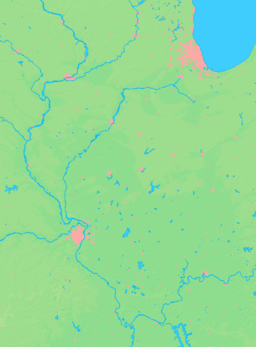Bonfield, Illinois
| Bonfield | |
| Village | |
| Country | United States |
|---|---|
| State | Illinois |
| County | Kankakee |
| Elevation | 630 ft (192 m) |
| Coordinates | 41°8′50″N 88°3′30″W / 41.14722°N 88.05833°WCoordinates: 41°8′50″N 88°3′30″W / 41.14722°N 88.05833°W |
| Area | 0.49 sq mi (1 km2) |
| - land | 0.49 sq mi (1 km2) |
| - water | 0.00 sq mi (0 km2) |
| Density | 1,328.9/sq mi (513/km2) |
| Timezone | CST (UTC-6) |
| - summer (DST) | CDT (UTC-5) |
| Postal code | 60913 |
| Area code | 815 & 779 |
  Location of Bonfield within Illinois
| |
| Wikimedia Commons: Bonfield, Illinois | |
Bonfield is a village in Kankakee County, Illinois, United States. Bonfield's population was 364 at the 2000 census. It is included in the Kankakee-Bradley, Illinois Metropolitan Statistical Area.
Although founded by quarryman Thomas Verkler, the village was named after Thomas Bonfield, an attorney for the Kankakee & Seneca Railroad Company, which established a depot in the village. A name was needed for this depot, someone suggested "Bonfield", and that's what stuck. The railroad has long since disappeared into history but it had been on Johnson Street. Old railroad spikes and ties might still be found around the limestone quarry. The depot was moved about a mile and a half south of the village and converted to a barn, which remained as of December 31, 2007. The town originally had a high school, but it burned down in the early 1930s. Students then went to Herscher High School in Herscher.
Geography
Bonfield is located at 41°8′50″N 88°3′30″W / 41.14722°N 88.05833°W (41.147190, -88.058219).[1]
According to the 2010 census, Bonfield has a total area of 0.49 square miles (1.27 km2), all land.[2]
Demographics
| Historical population | |||
|---|---|---|---|
| Census | Pop. | %± | |
| 1890 | 150 | — | |
| 1900 | 165 | 10.0% | |
| 1910 | 162 | −1.8% | |
| 1920 | 126 | −22.2% | |
| 1930 | 116 | −7.9% | |
| 1940 | 116 | 0.0% | |
| 1950 | 143 | 23.3% | |
| 1960 | 178 | 24.5% | |
| 1970 | 241 | 35.4% | |
| 1980 | 294 | 22.0% | |
| 1990 | 299 | 1.7% | |
| 2000 | 364 | 21.7% | |
| 2010 | 382 | 4.9% | |
| Est. 2015 | 373 | [3] | −2.4% |
As of the census[5] of 2000, there were 364 people, 122 households, and 102 families residing in the village. The population density was 1,328.9 people per square mile (520.5/km²). There were 129 housing units at an average density of 470.9 per square mile (184.5/km²). The racial makeup of the village was 98.35% White, and 1.65% from two or more races. Hispanic or Latino of any race were 1.37% of the population.
There were 122 households out of which 46.7% had children under the age of 18 living with them, 73.0% were married couples living together, 10.7% had a female householder with no husband present, and 15.6% were non-families. 13.9% of all households were made up of individuals and 5.7% had someone living alone who was 65 years of age or older. The average household size was 2.98 and the average family size was 3.26.
In the village the population was spread out with 32.1% under the age of 18, 6.0% from 18 to 24, 32.7% from 25 to 44, 19.2% from 45 to 64, and 9.9% who were 65 years of age or older. The median age was 33 years. For every 100 females there were 90.6 males. For every 100 females age 18 and over, there were 90.0 males.
The median income for a household in the village was $49,722, and the median income for a family was $55,972. Males had a median income of $45,833 versus $24,000 for females. The per capita income for the village was $18,531. About 2.8% of families and 2.6% of the population were below the poverty line, including none of those under the age of eighteen or sixty-five or over.
Popular culture
The single payphone in town, during a time when payphones normally could be found anywhere, near the corner outside the town's only gas station and a portion of the main street were featured in the opening scenes of The Hunter, Steve McQueen's final movie.[6] It was also mentioned in the Kankakee County Journal at the time of filming in the summer of 1979.
References
- ↑ "US Gazetteer files: 2010, 2000, and 1990". United States Census Bureau. 2011-02-12. Retrieved 2011-04-23.
- ↑ "G001 - Geographic Identifiers - 2010 Census Summary File 1". United States Census Bureau. Retrieved 2015-08-02.
- ↑ "Annual Estimates of the Resident Population for Incorporated Places: April 1, 2010 to July 1, 2015". Retrieved July 2, 2016.
- ↑ "Census of Population and Housing". Census.gov. Archived from the original on May 11, 2015. Retrieved June 4, 2015.
- ↑ "American FactFinder". United States Census Bureau. Archived from the original on 2013-09-11. Retrieved 2008-01-31.
- ↑ The Hunter, 1980-08-01, retrieved 2015-08-01